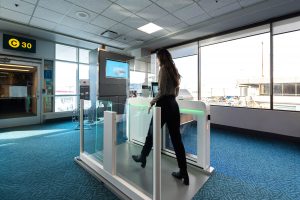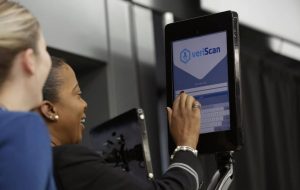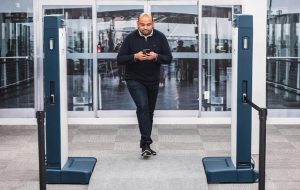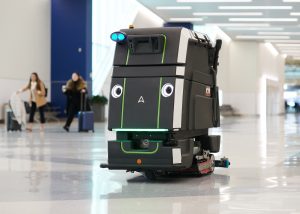Digital identification, facial recognition, biometric boarding passes and autonomous robots are among the new technologies you’ll see on your next trip to the airport (and beyond). As long lines and flight delays have lessened the quality of air travel for many of late, airline operators and facility managers seek to improve the travel experience for passengers and boost the bottom line for carriers by using the latest tools and procedures.
Reflecting trends at top airports around the world, Air Canada is the first airline here to pilot a digital identification project that lets passengers use new facial recognition technology to confirm identification in hopes of speeding up the boarding process.

Air Canada’s digital identification is now available for customers departing from Vancouver International Airport (YVR) when boarding select flights to Winnipeg, and for eligible customers entering the Air Canada Café at Toronto Pearson International Airport. (CNW Group/Air Canada)
Air Canada’s digital identification is initially available for customers flying out of Vancouver International Airport (YVR) on select flights to Winnipeg, and for eligible customers entering the Air Canada Café at Toronto Pearson International Airport. Air Canada says it plans to expand digital identification options to other Canadian airports and Maple Leaf Lounges as part of its pilot project phase.
Eligible flyers have been sent a special invitation to use the digital identification option in the Air Canada mobile app, along with instructions on how to create a ‘secure digital faceprint’ before heading to the airport.
Users are prompted to take a picture of their passport, scan the passport chip, then take a selfie. Facial recognition tools measure and compare the faces in both images, authenticating them if they match.
Customers who do not want to use the new digital identification can still board as usual by presenting their boarding pass and government-issued photo ID for manual check and processing. Likewise, customers can still choose to have their boarding cards scanned manually to get into the Air Canada Café at Toronto Pearson.
Those customers who do use the new digital ID must provide additional consent for their data to be used day-of travel and retained for up to 36 hours, subject to Air Canada’s privacy and security standards. Biometric data is encrypted and stored only on the customer’s mobile phone, and Air Canada says, information from the digital profile is shared only with its Canadian biometrics technology provider, which processes personal information in Canada only.
Air Canada’s digital identification is strictly an optional, consent-based program. It is not related to any government-sponsored program like NEXUS, Global Entry or U.S. Customs and Border Protection Mobile Passport Control (MPC).
Meanwhile, U.S. Customs and Border Protection is holding a voluntary test for airlines and cruise ships using the Traveler Verification Service (TVS) and its facial / identification systems so they meet evolving Advance Passenger Information System (APIS) requirements.
Other recent trials of mobile app-based identification systems are underway, such as the solution from Mastercard. It combines its digital identity services with technology called the Smart Path passenger processing platform from SITA to allow enrolled digital ID holders access to airport locations simply by having their face scanned. And Seychelles International Airport is one that has opened a “fully biometric corridor” built by Travizory for contactless checking of inbound passengers’ identities and health status.

Biometric identification technology from VeriScan is used at check-in counters, airline lounges, boarding gates, and more.
No high-tech scanning corridor is needed for the commercial tablet- and mobile phone-based biometric identification technology from VeriScan, now used at check-in counters, airline lounges, boarding gates and elsewhere. The cloud-based service combines its platform with Okta identity management software and AirWatch for mobile device management and security.
Seeking to further boost airport security and reduce transit times, along with the more sophisticated digital identification systems at Pearson, a new artificial intelligence-powered security system from Liberty Defense called HEXWAVE will be deployed, according to a letter of purchase intent between the two.

HEXWAVE uses AI to detect dangerous or prohibited items, and cellphones do not trigger warnings from the walk-through security portals.
The HEXWAVE solution is a walk-through detector that incorporates AI to detect prohibited or dangerous items much more quickly and easily than long screening line-ups and manual checks. Detectors can be installed at boarding gates, but also elsewhere in an airport facility, including terminal entrances. The detection system is designed to let passengers keep benign items (like cellphones, car keys and wallets) on their person, while looking only for what airport management calls “items of concern.”
Not to treat the topic too lightly, but some air travellers see garbage, litter and other disposables as items of concern when it comes to airport cleanliness and hygiene.

The use of Avidbots’ autonomous floor scrubbing robot, Neo, has saved thousands of hours of labour for some of the world’s cleanest airports. (Photo: Business Wire)
So word that a Canadian-based robotics manufacturer has recently secured $70 million USD in Series C funding to accelerate its timelines for bringing new autonomous floor scrubbers to market will be good news.
Avidbots has been a leader in the robotic cleaning market since its founding in 2014, continuously improving its autonomous driving software and customer services.
Its autonomous floor scrubber Neo has received an international award from Skytrax, an aviation rating firm, as a leading technology contributor to airport terminal comfort, cleanliness and hygiene at top airports around the world.
Air travellers should also know that, while not directed specifically at any one technology or application, the Canadian federal government has, in its latest budget, promised to spend nearly $2 billion over the next five years for the Canadian Air Transport Security Authority (CATSA); the government is set to increase the passenger-paid Air Travel Security Charge as a result.
-30-



